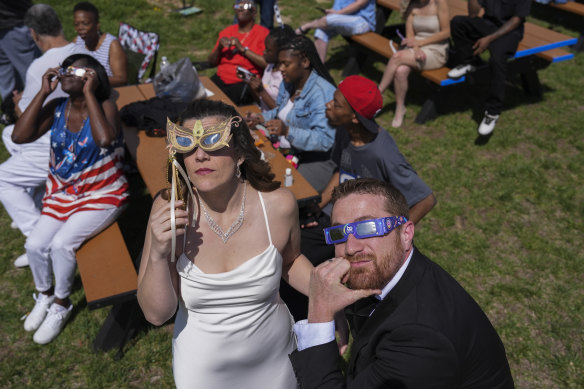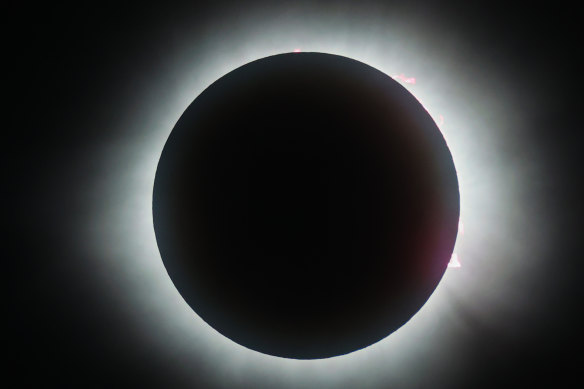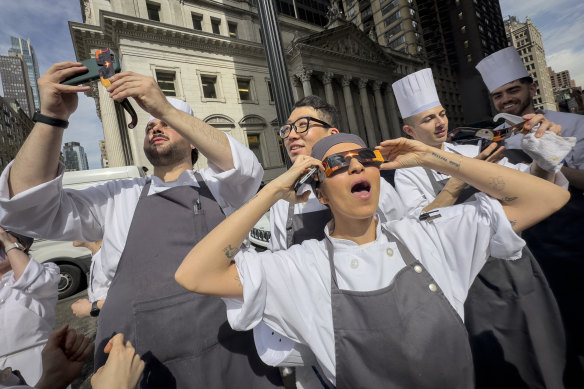
Arkansas and northeast New England were the best bets in the US, going into Monday’s spectacle. New Brunswick and Newfoundland in Canada also looked promising.
The show got underway in the Pacific before noon EDT (2am AEST). As the darkness of totality reached the Mexican resort city of Mazatlán, the faces of spectators were illuminated only by the screens of their mobile phones.
The cliff-hanging uncertainty added to the drama. But the overcast skies in Mesquite near Dallas didn’t rattle Erin Froneberger, who was in town for business and brought along her eclipse glasses.

Samantha Palmer, left, and Gerald Lester watch a total solar eclipse before getting married during the event in Trenton, Ohio.Credit: AP
“We are always just rushing, rushing, rushing,” she said. “But this is an event that we can just take a moment, a few seconds that it’s going to happen and embrace it.”
A festival outside Austin wrapped up early on Monday because afternoon storms were in the forecast. Festival organisers urged everyone to pack up and leave.
Sara Laneau, of Westfield, Vermont, woke up at 4am Monday to take her 16-year-old niece to nearby Jay Peak ski resort to catch the eclipse after a morning on the slopes.

The sun disappears behind the moon during the Great North American Eclipse in Mazatlan, Mexico.Credit: Getty
“This will be a first from me and an experience of a lifetime,” said Laneau, who was dressed in a purple metallic ski suit with a solar eclipse T-shirt underneath.
At Niagara Falls State Park, tourists streamed in under cloudy skies with wagons, strollers, coolers and lawn chairs. Park officials expected a large crowd at the popular site overlooking the falls.
During Monday’s full eclipse, the moon slipped right in front of the sun, entirely blocking it. The resulting twilight, with only the sun’s outer atmosphere or corona visible, would be long enough for birds and other animals to fall silent, and for planets, stars and maybe even a comet to pop out.
The out-of-sync darkness lasts up to 4 minutes and 28 seconds. That’s almost twice as long as it was during the US coast-to-coast eclipse seven years ago because the moon is closer to Earth. It will be another 21 years before the US sees another total solar eclipse on this scale.
It will take just 1 hour, 40 minutes for the moon’s shadow to race more than 6500 kilometres across the continent.
Eye protection is needed with proper eclipse glasses and filters to look at the sun, except when it ducks completely out of sight during an eclipse.
The path of totality — approximately 185 kilometres wide — encompasses several major cities this time, including Dallas; Indianapolis; Cleveland; Buffalo, New York; and Montreal. An estimated 44 million people live within the track, with a couple hundred million more within 320 kilometres.
“This may be the most viewed astronomical event in history,” said National Air and Space Museum curator Teasel Muir-Harmony, standing outside the museum in Washington, awaiting a partial eclipse.

Restaurant workers in the Flatiron district of Manhattan take a break to view the solar eclipse.Credit: AP
Experts from NASA and scores of universities are posted along the route, poised to launch research rockets and weather balloons, and conduct experiments. The International Space Station’s seven astronauts also will be on the lookout, 435 kilometres up.
AP



























